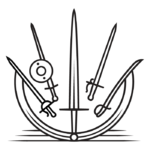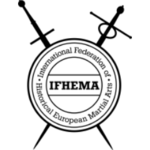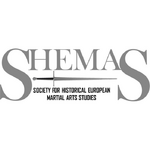Dedicated to the memory of Dr. Patri Pugliese
Wiktenauer is an ongoing collaboration among scholars and practitioners from across the Western martial arts (WMA) community, seeking to collect all of the primary source materials that makes up the text of historical European martial arts (HEMA) research and to organize and present it in a rigorous but accessible format. The Wiktenauer project started in 2009, later moving under the umbrella of the 501(c)(3) HEMA Alliance, and is named for Johannes Liechtenauer, grand master of the best-documented tradition of the early Modern era, the subject of many dozens of manuscripts and books over a period of nearly three centuries.
Wiktenauer's data model is built on separating the contents of each master's teachings from the books and manuscripts that contain them. For this reason, there are two main types of pages:
Treatise Pages host all relevant data on an individual book or manuscript, including codicological description, provenance (for manuscripts) or publication history (for books), table of contents (with links to the appropriate master pages), gallery of page scans, and bibliography of print resources. The exemplar for manuscripts is the Goliath Fechtbuch, while the exemplar for printed books is Ergrundung Ritterlicher Kunst der Fechterey. With well over a thousand individual books and manuscripts to research, building out this index will take a long time. Ultimately, every text in the corpus of Historical European Martial Arts literature will have a dedicated page.
Master Pages display the actual transcription and translation of a given master's complete works, as well as bibliographical information when available. In cases of multiple copies of a master's work, the transcriptions are laid out side-by-side to facilitate cross-comparison and creating the most accurate translation possible. To aid in interpretation, the writings are also illustrated with pictures from the masters' work (when available). A bibliography at the end of each page lists additional transcriptions, translations, and scans that are available in print. The exemplar for this category of pages is Fiore de'i Liberi. Ultimately, every master in all of the traditions of Western Martial Arts will have a dedicated page. (Anonymous texts are displayed on 'orphan treatise' pages, which are structured like master pages but without the biography.)
The Wiktenauer index is currently considered complete up to the end of the 16th century, and we're currently working on adding material from the 17th (while also trying to keep the existing pages up to date with the latest discoveries and published research).
If you'd like to pitch in, simply request an account and consult How can I help?
Announcements
|
|
From our sister site HROARR:
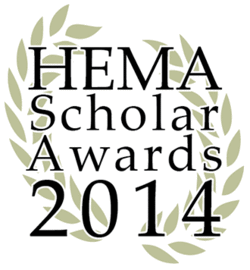 Rules for nomination and other information can be found here. As we all know HEMA has many different aspects that are all equally important in our shared effort in recreating these forgotten martial arts.
However, all of our success rests on the hard work of researchers, transcribers, translators and interpreters, hard work, a work that often receives little recognition or actual reward in the way that tournament fighting does, not least since much work is done silently and generously published online for free.
With this in mind, and acting as a neutral party within the HEMA community, in 2013 HROARR introduced annual awards for Best efforts in HEMA research, with all aspects it includes. The idea was to create a highly prestigious award, our very own Oscar or Nobel Prize, if you will.
Each year 5 winners are awarded. Nominations are up to the community to send in, and decisions are based on actual achievements during the preceding year, not through community voting. At this time, all published work has to have been written in English, except for transcriptions, of course.
Decisions will be made by a quite small panel consisting of last year’s awardees and if needed new elected jury members. As the awards become more and more established, these awards will also be more and more independently managed by the new juries and the growing list of awardees and less so by HROARR.
All winners will be presented on a special awards page, where the winners for each year are listed with their achievements.
I sincerely hope this will serve as both an inspiration and an encouragement for all the hard working people in our community!
Thank you and have a great day, everyone!
- Roger Norling
Responsible publisher and Chief Editor
HROARR.com
|
|
|
What's New?
|
| “Die Blume des Kampfes”
|
| The Flower of Battle
|
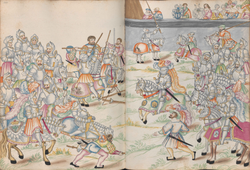
|
|
|
| Author(s)
|
|
| Ascribed to
|
|
| Illustrated by
|
Unknown
|
| Date
|
before 1420s
|
| Genre
|
|
| Language
|
Early New High German
|
| State of Existence
|
Original hypothetical; multiple incomplete copies exist
|
| Manuscript(s)
|
|
| Concordance by
|
Michael Chidester
|
Die Blume des Kampfes (“The Flower of Battle”) is a nickname given to a group of three German manuscripts that share a common technical syllabus and set of illustrations. It might be based on the tradition of 14th century Italian master Fiore de'i Liberi, from whose treatise Fior di Battaglia it derives its nickname, given that his works include considerable technical overlap. It is equally likely, though, that they represent an earlier German tradition of which Fiore was himself an initiate. Fiore mentions in his prefaces that he owned books on the art and he also names two older masters in his tradition, Johane Suveno and Nicholai de Toblem; it is possible that either or both of those masters authored texts which inspired both this tradition as well as Fiore's own writings.
The oldest manuscript in the Blume des Kampfes group is the Cod. 5278, which dates to the late 1420s and contains only simple line drawings somewhat reminiscent of the art of Fiore de'i Liberi, though lacking many signature characteristics such as garters and crowns and generally less organized than the Friulian master's work. The second entry was completed in ca. 1500 by Ludwig VI von Eyb, and contains a significant degree of overlap with the 5278 but also a wealth of new material. While the artwork, though colored, is of similar quality, Eyb's treatise improves on its predecessor by including detailed German descriptions of the devices in most of its sections. Whether this text was authored by Eyb or present in the sources upon which he based his work cannot currently be determined.
The final manuscript, Cod. 10799, is dated 1623 and is again textless. Unlike its fellows, though, it is illustrated with watercolors of high quality; it is also the most extensive of the three by far, encompassing nearly every device from both works as well as a number of unique devices that suggest that it was either not derived directly from the other two known manuscripts or that it used additional sources currently lost to us. The two older manuscripts include war books derived from Konrad Kyeser's famous treatise on siege warfare Bellifortis, and the artist of the 10799 also included the few Bellifortis illustrations that seem to portray knights and soldiers, perhaps indicating that he did not understand what he was copying. Aside from the Blume des Kampfes material, the 10799 also has a good deal of extra content including portrayals of laying down and taking up the sword, Germanic sash wrestling, armored dagger and buckler, and the sword dance.
There is a fourth Germanic manuscript potentially connected to this tradition, the Cod.Guelf.78.2 Aug.2º. This manuscript, dating to between 1465 and 1480, includes a version of Johannes Liechtenauer's record, a complete set of illustrations from Gladiatoria, and a heavily-abridged version of Bellifortis. Tucked away amidst these works are illustrations of fencing with sword, spear, axe, and dagger that parallel the teachings of the Blume des Kampfes but only occasionally replicate the artwork exactly. While this may simply be a case of an overambitious artist reinterpreting the illustrations he was copying, the differences are too many to include the manuscript in the concordance below.
(Read more...)
|
|
|
|
Wiktenauer parent organizations
Historical European Martial Arts Federations
Each year Wiktenauer holds a two-week fundraising drive to cover our server fees and fund new projects and acquisitions. The following are the organizations are official sponsors of the 2015 fundraiser; a full list of donors can be viewed on the Contributors page.
Top three 2015 donors




